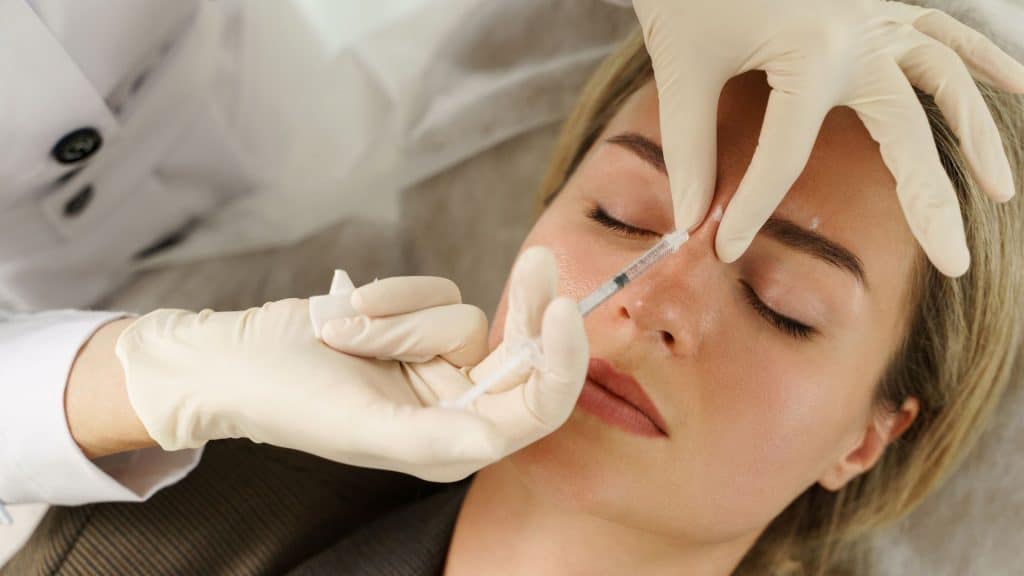Facial fillers, also known as dermal fillers, are used to temporarily make a person’s face appear rested, rejuvenated, and younger. These injections can plump thinning lips, lift eyebrows, enhance cheekbones, erase under-eye circles, and smooth smile lines. When considering dermal fillers, it’s essential to understand the differences between various options.
Two popular dermal fillers, Ellanse and Sculptra, offer distinct benefits. Ellanse, composed of polycaprolactone microspheres, stimulates collagen production and provides long-lasting results. Sculptra, conversely, contains poly-L-lactic acid, gradually enhancing volume over time. Both fillers address different needs, making them suitable for specific patients and treatment goals.
In this article, we will explore Ellanse’s and Sculptra’s unique characteristics, comparing their mechanisms, longevity, and ideal use cases for informed decision-making.
Key Takeaways
- Ellanse fillers are made of Polycaprolactone (PCL) microspheres suspended in a gel carrier. They provide immediate facial volume and stimulate natural collagen production. On the other hand, Sculptra uses polylactic acid (PLLA) to promote collagen growth over time.
- Ellanse enhances facial contours, defines cheeks, smooths deep lines, and rejuvenates the entire face, with results lasting up to four years. Sculptra requires multiple sessions initially but can extend its effects beyond five years, focusing on broader facial enhancement.
- Ellanse’s PCL microspheres provide instant smoothing effects and initiate collagen growth upon injection. Sculptra’s PLLA particles activate fibroblasts, which are crucial for collagen synthesis and offer gradual improvement over several treatments.
- Ellanse has four types with varying durations, allowing personalized treatment plans. Sculptra, though requiring more sessions, also shows long-term collagen stimulation and high patient satisfaction, with effects potentially lasting longer than Ellanse.
Composition and Mechanism of Action

- Ellanse: Polycaprolactone (PCL) microspheres form the core of Ellanse fillers. These microspheres are suspended in a gel carrier, allowing smooth injection into the skin. Ellanse’s unique ability to provide immediate facial volume and reduce wrinkles while stimulating natural collagen production over time. Doctors use Ellanse to enhance facial contours by defining cheeks and cheekbones, smoothing out deep lines, and rejuvenating the face overall.
- Sculptra: Sculptra functions through poly-L-lactic acid (PLLA), primarily focusing on building new collagen over time. Approved by the FDA in 2004 for treating adipose atrophy in HIV patients, its PLLA particles prompt fibroblast activation—a critical step in collagen synthesis.
Both fillers trigger the body’s natural response to produce collagen, which helps restore and maintain skin elasticity and firmness.
Clinical Efficacy

Ellanse and Sculptra are known for their long-lasting effects on facial rejuvenation. Ellanse offers results lasting up to four years due to its unique polycaprolactone (PCL) microspheres that stimulate collagen production. In contrast, Sculptra, made from poly-L-lactic acid (PLLA), provides results lasting up to two years by gradually replacing lost collagen in the skin.
Both fillers are highly effective in enhancing skin texture and restoring facial volume. Ellanse provides immediate volume and stimulates collagen production, leading to smoother and firmer skin. Sculptra, meanwhile, gradually improves skin texture by promoting collagen growth, resulting in a more natural-looking enhancement of facial contours.
Clinical studies and expert reviews have highlighted the efficacy of both fillers in addressing age-related volume loss and skin aging. These resources provide valuable insights into the performance of Ellanse and Sculptra, helping medical professionals make informed decisions based on scientific evidence and real-world experiences.
Safety Profiles

Tenderness or redness at the injection site is often seen with Ellansé and Sculptra treatments. These common side effects show up shortly after the procedure. Patients might also notice swelling or bruising.
Both Ellanse and Sculptra can cause rare complications. These include swelling or bruising at the injection site. Such reactions are uncommon but do happen. The body might also have inflammatory tissue reactions after getting these treatments. This is rare, but doctors must watch for it after the procedure.
Ellanse and Sculptra share similar safety concerns regarding unusual complications. Doctors should be carefully ready to handle adverse reactions like tissue inflammation. Monitoring patients after their procedures is critical to catching rare adverse outcomes early on.
| Criteria | Ellanse | Sculptra |
| Composition | Polycaprolactone (PCL) microspheres | Poly-L-lactic acid (PLLA) |
| Common Side Effects | Swelling, redness, tenderness at the injection site | Swelling, redness, tenderness at the injection site |
| Rare Complications | Small nodules within a year after injection | Inflammatory tissue reactions are infrequent |
| Management of Complications | Hyaluronidase for dissolving | Hyaluronidase for dissolving |
| FDA Approval Status | Not explicitly listed | Yes, received FDA approval |
| Safety Record | Good, with minimal side effects | Good, with minor side effects |
Practical Considerations
Ellanse dermal filler adds volume to specific spots well, making it an excellent choice for targeted facial filler placement, such as cheek or jawline enhancement. It uses Polycaprolactone (PCL) microspheres to do the job right where needed.
On the other hand, Sculptra goes beyond just one spot. Its Poly-lactic acid (PLLA) formula can spread out to refresh a more significant part of your face. Think of areas that need a boost rather than just one line or wrinkle.
These differences matter for patients looking at facial rejuvenation zones. If someone wants precise volume enhancement locations worked on, Ellanse is the way to go. However, Sculptra is better if its goal is more about general facial sculpting zones and broadly improving skin texture.
People like having options, and Ellanse offers four varieties that last a long time. This flexibility meets individual needs well, boosting satisfaction. Sculptra’s approach is more gradual, needing monthly treatments for three to four months. This can be less satisfying for some patients because they must wait longer to see results.
The cost of treatment with Ellanse and Sculptra may vary based on factors such as the amount of product used and the provider’s pricing. Medical professionals should consider the cost implications for their patients when recommending a filler.
| Treatment | Initial Treatment Cost | Follow-Up Treatments | Annual Maintenance | Total Estimated Cost Over 2 Years |
| Ellanse™ | $800 – $1,200 | None required for up to 2-4 years, depending on the product version (S, M, L, E) | $0 for the first 2-4 years | $800 – $1,200 |
| Sculptra | $600 – $1,000 per session | 2-3 sessions required in the first year | $600 – $1,000 yearly for maintenance | $2,400 – $4,000 |
Conclusion
Choosing between Ellanse and Sculptra depends on your needs. Ellanse works fast and is excellent for quick volume in certain spots. Sculptra changes things slowly but surely, and it is suitable for a significant area effect.
Think about what you want – immediate change or gradual improvement. Both have side effects like swelling and bruising, yet they’re manageable with care. This choice is crucial in meeting those facial rejuvenation goals you have in mind.
FAQs
1. What are Ellanse and Sculptra?
Ellanse and Sculptra are dermal fillers that enhance the skin’s appearance by reducing wrinkles and adding volume.
2. How do Ellanse and Sculptra differ from each other?
Ellanse and Sculptra have different compositions – with unique properties that affect their longevity, effect on the skin, and possible side effects.
3. Which is better for me – Ellanse or Sculptra?
The choice between Ellanse or Sculptra depends on your specific needs, desired results, and any potential allergies or sensitivities you may have.
4. Are there any risks associated with using these dermal fillers?
Like all medical treatments, Ellanse and Sculptra have potential risks, which should be discussed thoroughly with a healthcare professional before proceeding.
References
Angelo-Khattar M. (2022). Objective Assessment of the Long-Term Volumizing Action of a Polycaprolactone-Based Filler. Clinical, cosmetic and investigational dermatology, 15, 2895–2901. https://doi.org/10.2147/CCID.S385202
CSK Clinics. (n.d.). Comparing Ellanse & Sculptra fillers for facial rejuvenation. CSK Clinics. Retrieved from https://cskclinics.com/comparing-ellanse-sculptra-fillers-for-facial-rejuvenation/
Guo, J., Fang, W., & Wang, F. (2023). Injectable fillers: current status, physicochemical properties, function mechanism, and perspectives. RSC advances, 13(34), 23841–23858. https://doi.org/10.1039/d3ra04321e





















